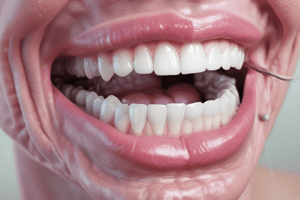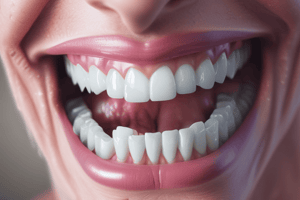Podcast
Questions and Answers
What is the most common site for ameloblastic fibroma?
What is the most common site for ameloblastic fibroma?
- Mandibular molar region (correct)
- Maxillary anterior region
- Mandibular anterior region
- Maxillary molar region
How does the age group affected by ameloblastic fibroma compare to conventional ameloblastoma?
How does the age group affected by ameloblastic fibroma compare to conventional ameloblastoma?
- It affects older age groups
- No age group difference
- It affects younger age groups (correct)
- It affects children only
What is the typical radiographic appearance of ameloblastic fibroma?
What is the typical radiographic appearance of ameloblastic fibroma?
- Both unilocular and multilocular
- Multilocular
- Unilocular (correct)
- Radiolucency with no specific pattern
How does the background surrounding tissue of ameloblastic fibroma differ from that of ameloblastoma?
How does the background surrounding tissue of ameloblastic fibroma differ from that of ameloblastoma?
What is a common feature associated with ameloblastic fibroma in radiographs?
What is a common feature associated with ameloblastic fibroma in radiographs?
What is the histological composition of the epithelium in ameloblastic fibroma?
What is the histological composition of the epithelium in ameloblastic fibroma?
Which odontogenic tumor is associated with pain mainly in the first molar region?
Which odontogenic tumor is associated with pain mainly in the first molar region?
What is the typical age range for patients affected by cemento-ossifying fibroma?
What is the typical age range for patients affected by cemento-ossifying fibroma?
Which odontogenic tumor causes a slowly enlarging painless swelling mainly in the molar and premolar region?
Which odontogenic tumor causes a slowly enlarging painless swelling mainly in the molar and premolar region?
Which odontogenic tumor is composed of dense mass of acellular cementum in a fibrous stroma?
Which odontogenic tumor is composed of dense mass of acellular cementum in a fibrous stroma?
What radiographic feature is associated with juvenile ossifying fibroma?
What radiographic feature is associated with juvenile ossifying fibroma?
What makes the extraction of a tooth affected by cementoblastoma very difficult?
What makes the extraction of a tooth affected by cementoblastoma very difficult?
Which odontogenic tumor variant is seen in younger patients?
Which odontogenic tumor variant is seen in younger patients?
What histological feature is characteristic of cemento-ossifying fibroma?
What histological feature is characteristic of cemento-ossifying fibroma?
Which odontogenic tumor variant used to be discussed in bone tumors, but recently moved to the WHO classification of odontogenic tumors?
Which odontogenic tumor variant used to be discussed in bone tumors, but recently moved to the WHO classification of odontogenic tumors?
Which odontogenic tumor was first included in the odontogenic tumors in the recent 2017 WHO classification?
Which odontogenic tumor was first included in the odontogenic tumors in the recent 2017 WHO classification?
What age group is most commonly affected by odontogenic myxoma?
What age group is most commonly affected by odontogenic myxoma?
Which odontogenic tumor is characterized by a 'soap bubble' appearance in radiographs and a 'tennis racket' appearance?
Which odontogenic tumor is characterized by a 'soap bubble' appearance in radiographs and a 'tennis racket' appearance?
What is the most common clinical presentation of odontogenic fibroma?
What is the most common clinical presentation of odontogenic fibroma?
Which odontogenic tumor is associated with impacted teeth and can sometimes cause bone expansion?
Which odontogenic tumor is associated with impacted teeth and can sometimes cause bone expansion?
What distinguishes complex odontomes from compound odontomes histologically?
What distinguishes complex odontomes from compound odontomes histologically?
What is the characteristic radiographic appearance of complex odontomes?
What is the characteristic radiographic appearance of complex odontomes?
Which structure is primarily affected by cementoblastoma?
Which structure is primarily affected by cementoblastoma?
What distinguishes odontogenic myxoma from ameloblastoma histologically?
What distinguishes odontogenic myxoma from ameloblastoma histologically?
Flashcards are hidden until you start studying




